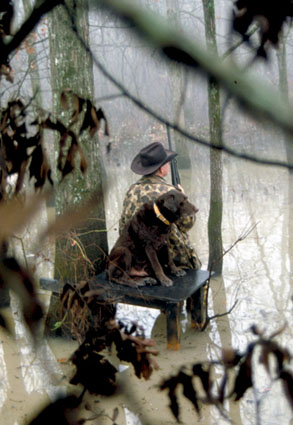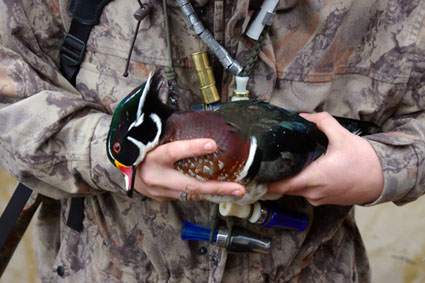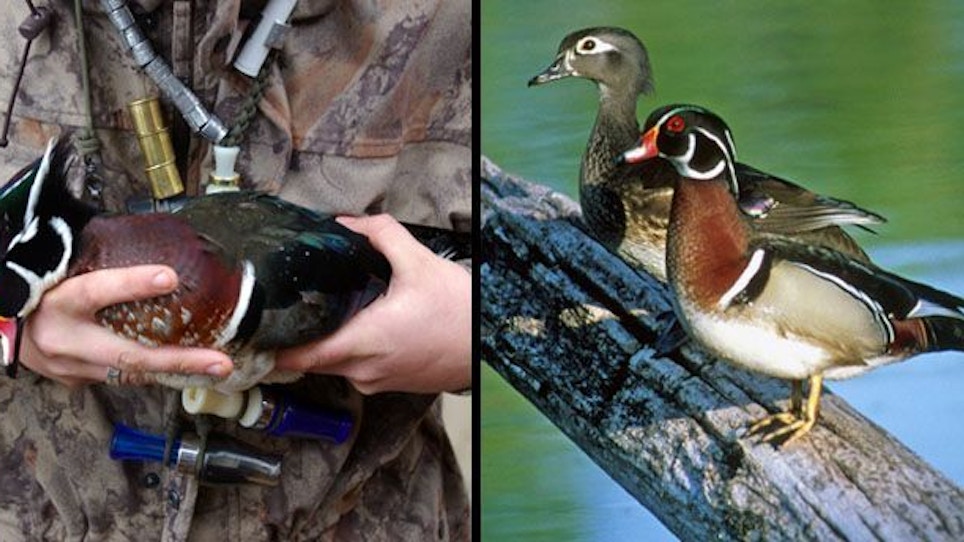 Shooting a wood duck in flooded timber is like trying to gun down a stone released from a slingshot, only harder.
Shooting a wood duck in flooded timber is like trying to gun down a stone released from a slingshot, only harder.
I came to this conclusion while hunting late-season ducks in a green-tree reservoir in eastern Arkansas. Mallards were scarce, but wood ducks were buzzing through the pin oaks like bumblebees around a flower garden.
My “purist” waterfowling companions, who hunt only mallards, agreed that the lack of greenhead action made woodies fair game — for me. They wouldn’t join in my follies, but I was told I would be “allowed” to try pass-shooting some of the birds streaking past our blind.
The wood ducks usually appeared in pairs, squealing loudly as they flew past. Oo-eek! Oo-eek. Their distinctive flight calls left no doubt how they earned the nickname “squealers.” Those that weren’t calling still were audible on their approach. The noise made as air rushed through their pinions closely resembled the sound of a bottle rocket fired on the Fourth of July.
It seemed that shooting one of the woodies would be an impossible task. And in several instances, my assumption was correct. Many birds passed at such breakneck speed, there wasn’t time to shoulder my shotgun and shoot. No problem, I thought. I’ll just keep my gun at the ready and take the next one that comes by. But after 15 minutes of waiting, I no longer could maintain a shooting stance. And, as one might expect, the instant I brought my shotgun down, two woodies flashed across the opening in the timber right in front of me.
My hunting companions found all this rather humorous. “You might as well give it up, Sutton,” one of them said, chuckling. “You’d have better luck hunting quail with a pea shooter.”
Undaunted, I continued my quest. And at 10 o’clock, almost four hours into the hunt, everything came together — sort of. I shouldered my shotgun, and almost immediately a pair of woodies came into view, flying fast from right to left, my favorite cross-shot swing. I swung ahead of the lead bird and fired. The rear bird fell.
“That bird out front was moving too fast for me to draw a bead on it,” I told my hunting buddies. “So I had to take the one behind it.”
“Well, lucky for you,” Bob said as he waded back with the duck in hand. “The one you got was a drake. It sure is a beauty.”
 Bob held in his hand a bird more beautiful than any I had ever seen, a bird of such gorgeous coloring, it hardly seemed real. Its glistening green head was crowned with a short rakish crest; its back was a blend of magnificent blues and purples that shimmered and glinted like gun metal; its breast was rich chestnut, and its sides the color of marigolds. The bird’s glossy bill was painted with broad brush strokes of red, black and white, and the large crimson eyes bore likeness to the glowing coals of a campfire. So brilliant were these colors, and so sharply contrasted, that the bird appeared to be painted. It was as if some skillful artist had spread upon its plumage the richest and most vivid pigments at his command; and yet there was nothing artificial in the effect produced, but, on the contrary, a perfection of beauty as natural as the beauty of a flower.
Bob held in his hand a bird more beautiful than any I had ever seen, a bird of such gorgeous coloring, it hardly seemed real. Its glistening green head was crowned with a short rakish crest; its back was a blend of magnificent blues and purples that shimmered and glinted like gun metal; its breast was rich chestnut, and its sides the color of marigolds. The bird’s glossy bill was painted with broad brush strokes of red, black and white, and the large crimson eyes bore likeness to the glowing coals of a campfire. So brilliant were these colors, and so sharply contrasted, that the bird appeared to be painted. It was as if some skillful artist had spread upon its plumage the richest and most vivid pigments at his command; and yet there was nothing artificial in the effect produced, but, on the contrary, a perfection of beauty as natural as the beauty of a flower.
When I was a youngster hunting ducks along east Arkansas’ L’Anguille River, we rarely saw wood ducks, and never shot them. They were scarce then, victims of market hunting and destruction of their bottomland hardwood habitat. Populations were protected by law. Fortunately, in the 45 years since I started hunting ducks, the wood duck has rebounded remarkably, and now ranks among our most plentiful game birds. We can hunt them without fear of harming the population, and for that, I am glad. I did not mind passing them by when they needed protection. And when mallards are plentiful in the woods I hunt, I probably won’t give a second thought to taking wood ducks. But on days like that day last season when mallards are scarce, the abundance of wood ducks gives me opportunity to take home game for the table. And for me, that, as much as anything, is the reason I hunt. I see beauty in wood ducks, but when I am hunting, my eyes follow them through the timber like a cat watches a canary. I hunt wood ducks because I know they provide the makings for memorable dinners.
And so, after admiring the wood duck I shot that morning, I returned to my hunting. And by noon, when our hunt ended, I had one more wood duck for the dinner table.
“You should be glad, Sutton,” one of my companions said, “that you don’t have to rely on your shooting skills for everything you eat.”
That I was. But I was already looking forward to the day when I could try again for these autumn-colored birds. Wood ducks are challenging targets for sure, but that’s what sets them apart from other, more commonly hunted species of waterfowl.






